MEM-C is finally on Instagram! Our IG has launched thanks to Chun-Chi Tseng and Xuetao Ma from Matt Yankowitz’s group. So, for now IRG-2 has the reigns on our posts!

MEM-C is finally on Instagram! Our IG has launched thanks to Chun-Chi Tseng and Xuetao Ma from Matt Yankowitz’s group. So, for now IRG-2 has the reigns on our posts!

MEM-C’s IRG-2 was busy last week with back-to-back seminars from some phenomenal visitors! Last Tuesday IRG-2 hosted Hu Miao, a researcher at Oakridge National Laboratory who brought us a presentation on his great work on correlated and topological quantum materials using ARPES and X-ray scattering.
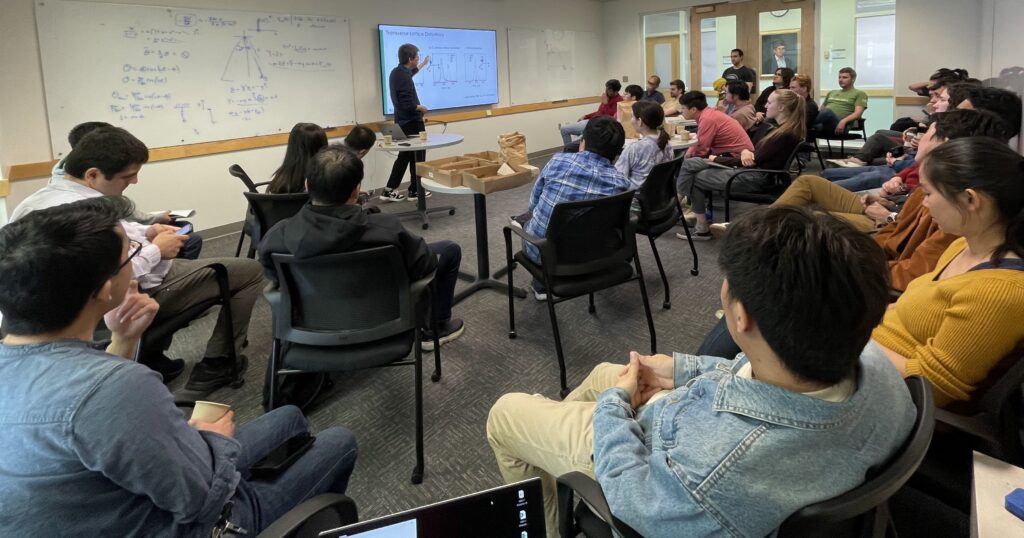
The title of Hu’s talk was “Chiral density waves in correlated quantum materials” and his abstract was:
Chirality, a geometrical concept that distinguishes an object from its mirror image, has been proposed for over three decades as a potential mechanism for novel quantum states including spontaneous quantum Hall liquids, chiral spin liquids, and magnetic skyrmions. Recently, chirality has experienced a revival in the context of correlated and geometrically frustrated electronic systems. In these settings, chiral spin, charge, orbital, and pairing fields become strongly coupled, giving rise to intertwined orders and long-range entangled quasiparticles. In this talk, I will present our recent progress and understanding of chiral charge, spin and pair density waves.
Last Thursday, many IRG-2 members attended a special seminar hosted by UW’s Department of Physics and the UW Thouless Institute for Quantum Matter. The special guest was Prof. Sanfeng Wu from Princeton. This seminar was very special for IRG-2 for many reasons! First and foremost, Prof. Wu is a UW almuni and former member of Xiaodong Xu’s group. Sanfeng’s PhD committee included Xiaodongl of coruse, and also IRG-2 Prof. Dave Cobden. His dissertation in 2016 was on 2D materials (near and dear to IRG-2’s heart) and defended just a couple of years before Cobden and Xu pubished MEM-C’s most highly cited research paper to-date in Nature on the incredible properties of 2D WTe2, “Ferroelectric switching of a two-dimensional metal“. Research in this area continues in both MEM-C and Sangeng’s reseach group at Princeton where he is a member of Princeton’s Center for Complex Materials which is also a NSF-funded MRSEC!
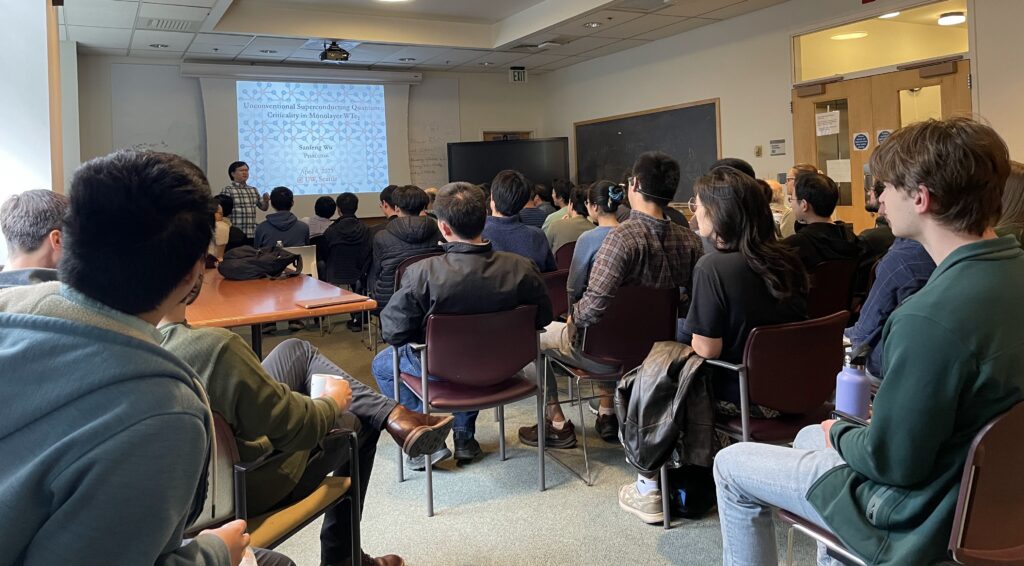
The title of Sangfeng’s presenation last week at UW was, “Unconventional Superconducting Quantum Criticality in Monolayer WTe2” and his abstract was:
Quantum critical points associated with quantum phase transitions are highly intriguing states of matter; yet they are difficult to study. An example is the superconductor to insulator or metal transition in two dimensions (2D), a topic of interest in condensed matter research for decades , but many problems remain unsolved. In this talk, I will discuss our recent experimental finding of a quantum critical point in monolayer tungsten ditelluride (WTe2), a unique 2D crystal in which topology, strong correlations and superconductivity all occur in a single material. We directly measure superconducting quantum fluctuations, whose behaviors are so anomalous that an unusual explanation beyond established theories is required.
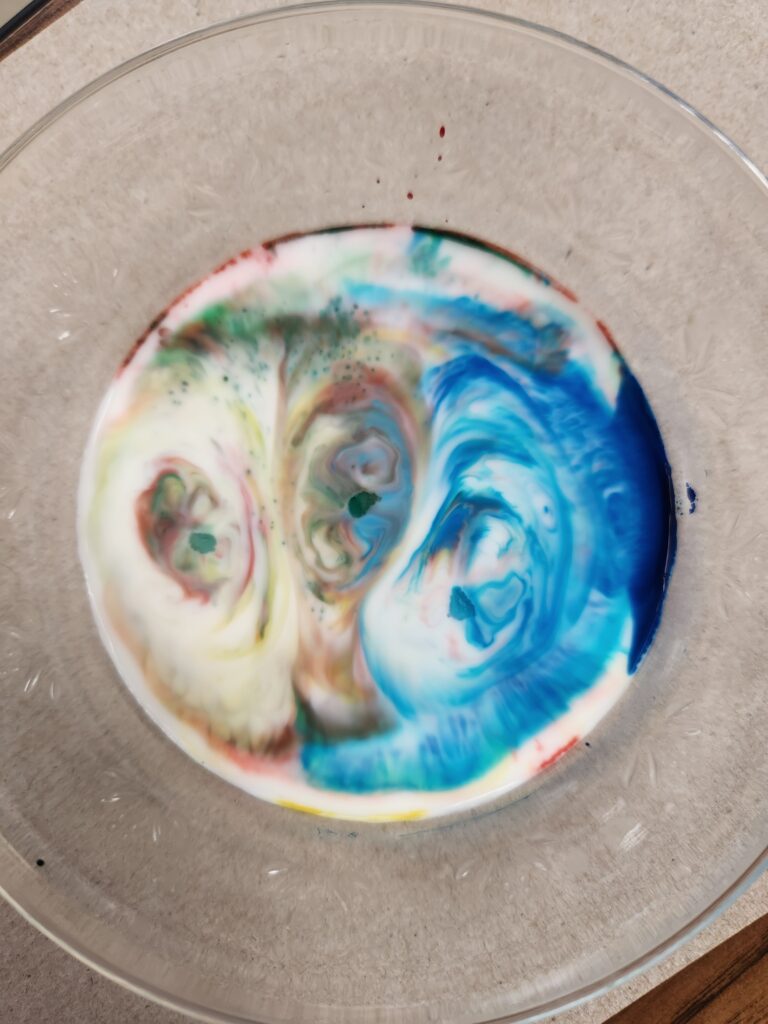
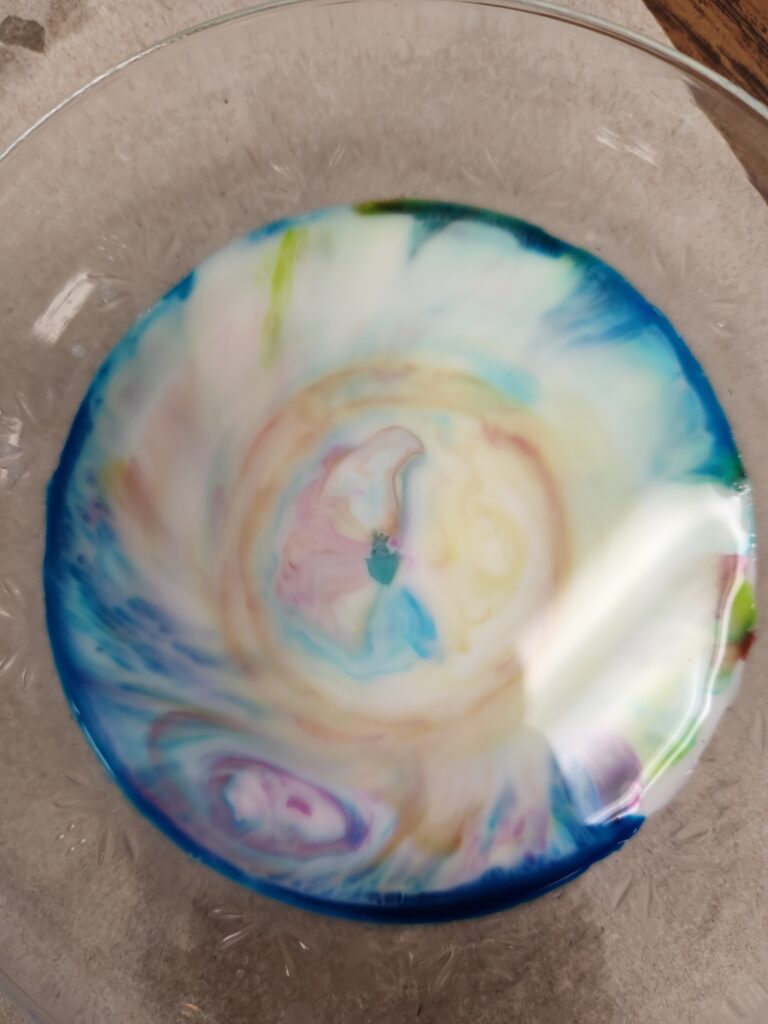
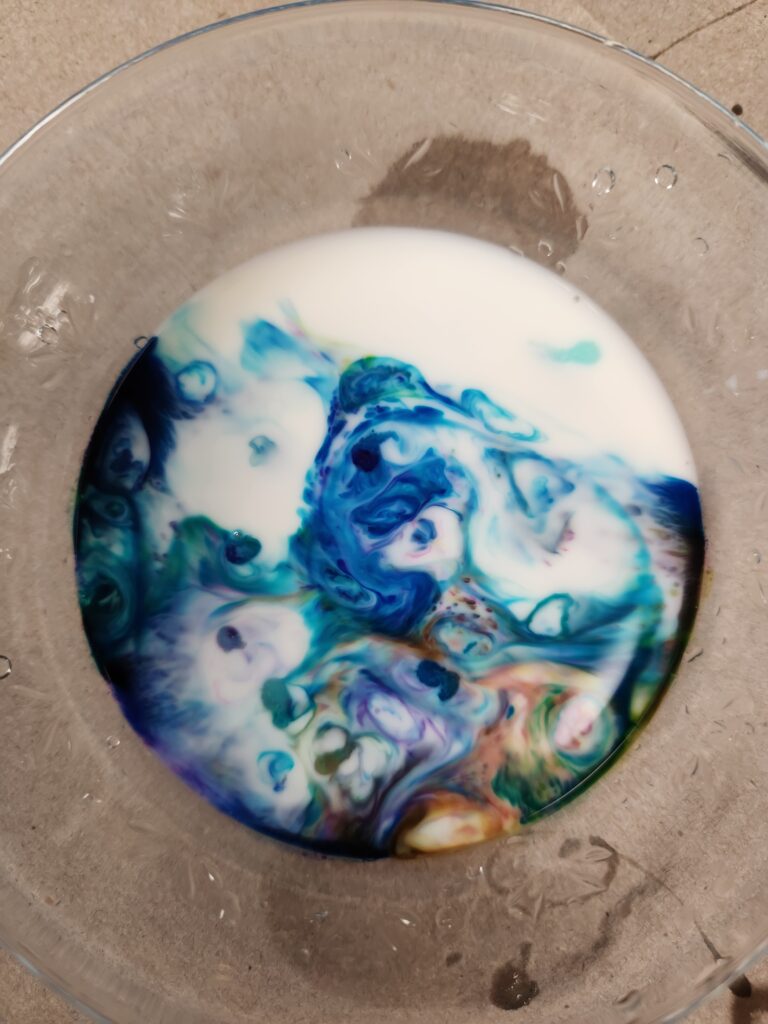
Earlier this month, MEM-C brought materials science–in the form of milk–to Echo Lake Elementary! The colorful (and slightly gross) activity involves milk, food dye, and dishsoap. It shows how the consituents of the milk (esp. the fats) are affected by soap! MEM-C graduate students William Bittner (Stoll Group), Eric Lester (Cobden Group) and Xueta Ma (Yankowitz Group) volunteered their time and Echo Lake PTA reported that they counted 253 students (and an estimated total of ~430 people) attending the event!

On November 29th, UW MEM-C had the pleasure of participating at Cedar Crest Academy’s Upper Elementary Family Engineering Night for 2nd – 5th graders. The event brought over 85 students and family members together to explore science with hands on activities offered by a few UW outreach programs and Cedar Crest Academy faculty and staff. Graduate students from UW MEM-C organized two activities focusing on the nanoscale that could be implemented with a few materials in a classroom setting.
Michael Riehs from the Velian lab (Chemistry) and William Bittner from the Stoll lab (Chemistry) helped students learn how to use graphite from pencils to draw a conductive path for a circuit to light up an LED. Students were able to draw any design and test the effects on the circuit, highlighting how a thin conductive path can be made with a simple material and how one can even obtain conductivity with a single-atom thick layer of graphite called graphene.
Christian Pederson from the Fu lab (Physics) and Andrea Carroll (UW MEM-C Education Director) helped participants explore the colloidal aspect of chemistry in everyday materials in an activity dubbed “milk volcanoes.” This activity involved adding a few drops of food dye to a small bowl of whole milk and then adding a drop of dish soap.
The different chemical compositions of the milk (fats, proteins, and water) and the soap (molecules with polar (hydrophilic) heads and non-polar (hydrophobic) tails) were discussed. As soon as the soap was added, the dye was quickly carried away from its starting location due to the intermolecular interactions between the soap molecules and the non-polar fats and polar proteins and water. The students enjoyed seeing the bright colors quickly move along the surface of the milk and create mesmerizing patterns that continued to evolve for more than ten minutes.
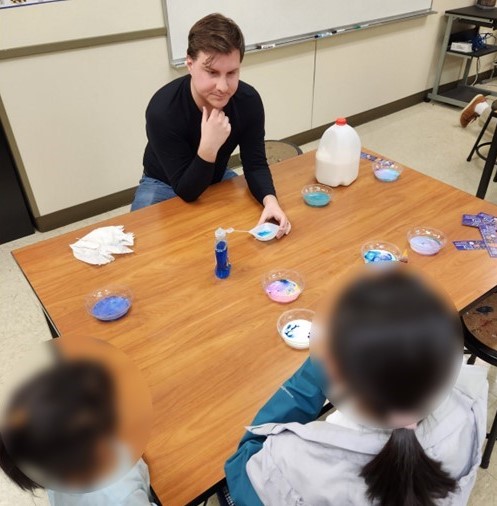
Throughout the event, the nanoscale aspect of each activity was emphasized, and students thoroughly enjoyed seeing how materials they use every day can yield interesting properties when discussed at the nanoscale.
Our materials science parternship continues to grow with our faculty partners at the University of Hawai’i Manoa. In October, Prof. Lilo Pozzo and graduate student Maria Polti traveled to Honolulu on behalf of MEM-C to work with UH MRE-C faculty member Prof. Joseph Brown and his lab in building a Jubilee tool for continued PREM research. The tool will accelerate the materials research at UH and will be incorporated into an experiment design course for mechanical engineering students. The UH students involved in the project included Cecilia Abella and Garett Costa, both of whom did research with MEM-C at UW last summer as visiting PREM scholars.
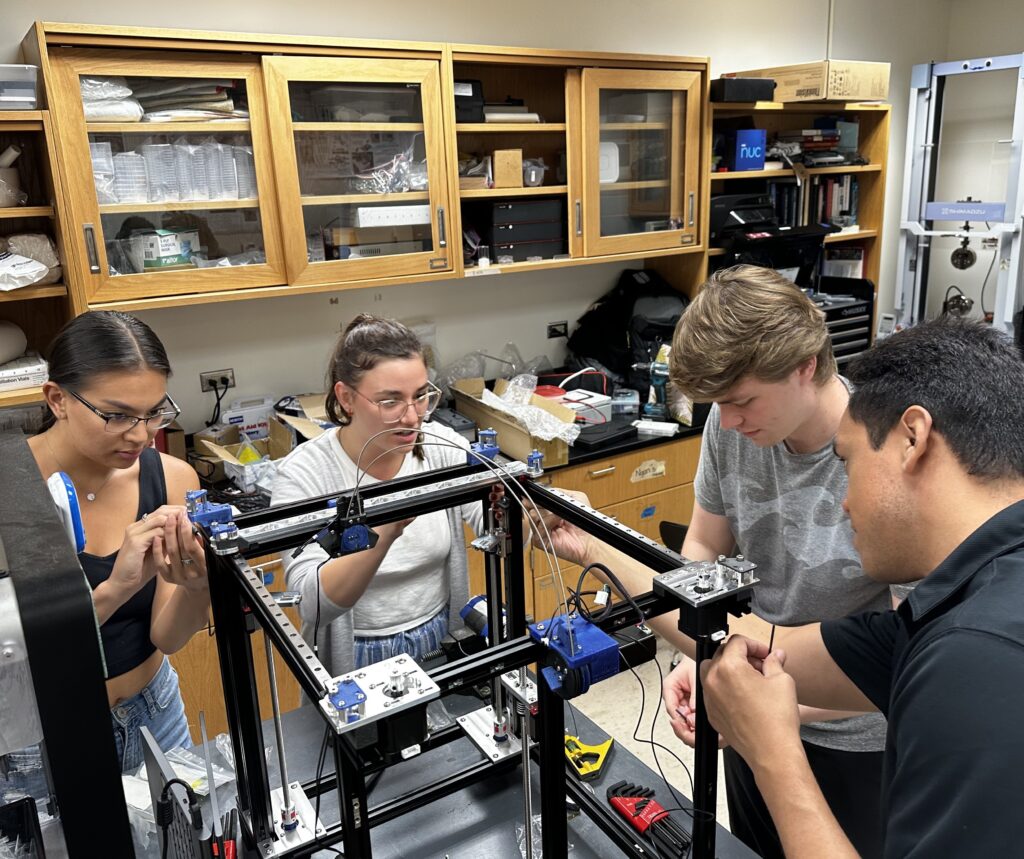
MEM-C joined the UW Department of Chemistry this week to celebrate the 2023 Nobel Prize in chemistry which was awarded to Moungi G. Bawendi, Louis E. Brus and Aleksey Yekimov for the discovery and development of quantum dots. The celebration included a presentation by Prof. Brandi Cossairt (IRG-1), Dr. Samantha Harvey (postdoc, IRG-1) and I-MOD students Sean Gallagher and Jessica Kline. The presentation was followed by questions from the audience and a small reception. MEM-C researchers continue to work on the puzzels that QDs bring and are excited to continue advancing this colorful field of nanoscience research!
For our latest work in the area, check out our publications page.
For a recording of the panel, visit UW Chemistry’s YouTube channel.
On September 14th, MEM-C welcomed 16 students and 7 parents from the Seattle homeschooling community for our inaugural “MEM-C Day.” Members of the Cossiart, Golder, Reed, and Xiao groups guided the students through hands-on laboratory activities aimed at giving students macroscopic representations of concepts involved in nanoscale research.

The outreach event was organized by Prof. Matthew Golder, Prof. Andrea Carroll, and MEM-C Education and Training Fellow Sarah Zeitler who is a PhD student in the Golder lab. The Golder group kicked off the event with a polymer activity in which students made slime and had the chance to alter the recipe and observe the effects of different recipes on the properties of the polymers they created.
The Reed group helped students create rainbow bookmarks by depositing an ultra-thin layer of clear nail polish on bookmarks the students decorated – the thickness of film remaining on each bookmark resulted in iridescent rainbow colors overlaying the students’ creations.
The Xiao lab guided students through building crystal structures from toothpicks and mini-marshmallows and making student messages written in “invisible” ink appear on a piece of paper. Heating the paper drives off water molecules remaining in the dried ink, altering the spectral properties of the dried ink and making the message appear.

The Cossiart lab wrapped up the event by giving students a chance to work with gold nanoparticles – they added reagents to alter the environment of the gold particles, creating solutions with new colors and properties.
We have opened our Fall 2023 application cycle for the Academic Year Research Accelerator REU (AYRA REU) program. The deadline for submissions is Monday, September 25th. This is a research experience for undergraduate students who have prior REU experience. Like the summer REU program, AYRA REU students will be embedded in one of the MEM·C labs for the academic year and work with graduate students, postdocs, and faculty to develop a research project. Different than the summer REU program, students will be working 10 to 19 hours per week and will engage in research for 3 quarters (Autumn, Winter and Spring). Full details and the application can be found at https://uwmemc.org/undergraduates/ayra-reu/.
The NSF announced in July that UW MEM·C would be 1 of only 9 institutions nationwide selected for MRSEC funding in the latest round of competition, placing UW in rare and distinguished company! The entire six-year, $18M award (DMR-2308979) comes to UW and starts September 1, 2023. The Center’s focus is primarily dedicated to supporting UW students, in addition to supporting shared user facilities that serve campus broadly and a vigorous education and outreach program. Our previous (2017-2023) MRSEC funding (DMR-1719797) additionally made UW eligible for two MEM·C-led NSF Partnership for Research and Education in Materials (PREM) awards that are presently supporting exciting partnerships with minority-serving institutions (U. Hawaii, Manoa and U. Central Florida) to advance diversity in STEM at UW and on those campuses, and this new MRSEC award will now make us eligible to compete for expansion of these partnerships in an upcoming NSF PREM proposal cycle. We look forward to 6 more fruitful years of MEM·C activities at UW!